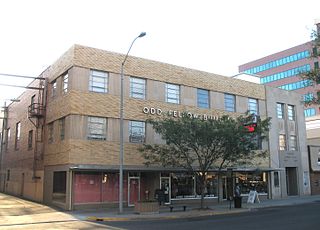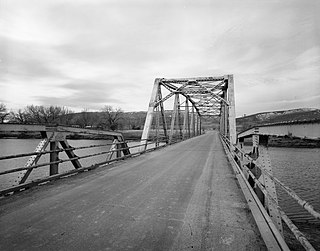
Independence Rock is a large granite rock, approximately 130 feet (40 m) high, 1,900 feet (580 m) long, and 850 feet (260 m) wide, which is in southwestern Natrona County, Wyoming along Wyoming Highway 220. During the middle of the 19th century, it formed a prominent and well-known landmark on the Oregon, Mormon, and California emigrant trails. Many of these emigrants carved their names on it, and it was described by early missionary and explorer Father Pierre-Jean De Smet in 1840 as the Register of the Desert. The site was designated a National Historic Landmark on January 20, 1961 and is now part of Independence Rock State Historic Site, owned and operated by the state of Wyoming.

The Bishop House in Casper, Wyoming was built in 1907. It was listed on the National Register of Historic Places in 2001.

The Ralston Community Clubhouse was built in 1914 as a community school in Ralston, Wyoming. It was abandoned as a school in 1922 when Ralston consolidated its school with the neighboring Powell school district. The Powell district offered the school to the Ralston Community Club in 1930. The clubhouse became the social center of Ralston, serving as a community meeting hall and polling place. It was particularly important to local women's organizations.

The Rialto Theater in Casper, Wyoming was built as the New Lyric Theater in 1921. It was constructed with 800 seats by Henry Brennan who had a successful Vaudeville house, on which he based the new cinema. He almost immediately sold the building in 1922 to new owner E.J. Schulte who invested $50,000 in a remodeling project designed by Casper architects William Dubois and Leon Goodrich. The reopening in 1922 featured the William C. deMille movie Nice People, a silent film that was accompanied by the Chicago Netto Ladies Orchestra. In 1928 the Rialto began to show talkies.

The Masonic Temple in downtown Casper, Wyoming is a Masonic hall, built in 1914 during a boom time initiated by the development of the Salt Creek Oil Field. Located on a corner site, the temple remains essentially as it was designed by Casper architect Homer F. Shaffer. The four story light-colored brick building rests on a raised basement and is topped by a crenelated parapet. The original windows have been replaced with vinyl units but retain the one-over-one appearance of the originals. Windows extend over the west and south sides. The north side is blank, while the east side is the building's rear facade and has fire escapes and a few windows.

The Roosevelt School in Casper, Wyoming, originally named North Casper School, was designed by leading Wyoming architectural firm Garbutt, Weidner & Sweeney in 1921 and was built in 1922. Need for the school followed from a post-World War I boom in Casper's economy and population, connected to a boom in the petroleum industry there. The school served as a neighborhood center in an otherwise-neglected area of the town.

The Union Pacific Athletic Club in Laramie, Wyoming, was built in 1928. Also known as Gray's Gables and as the Quadra Dangle Square Dance Clubhouse, it was built in log cabin style by Mads Justesen and Jack Haugum. It was listed on the National Register of Historic Places in 1978.
Leon C. Goodrich was an American architect of Casper, Wyoming. A number of his works are listed on the National Register of Historic Places.

The Odd Fellow Building or Odd Fellows Building, now known as Wolcott Galleria, is a historic building in Casper, Wyoming. It was built in 1952 and designed by architect Jan Wilking of local architectural firm Goodrich & Wilking. Casper's economy was then doing well and this building, unusual for Casper, was built with an arcade of first floor shops. The Odd Fellows used the second floor, which had a double-height ballroom. There were offices on the third.

The DUX Bessemer Bend Bridge was a Warren through truss bridge in Bessemer Bend, Wyoming, which carried Natrona County Road CN1-58 across the North Platte River. The bridge was built from 1921 to 1922. When nominated to the National Register of Historic Places in 1982, it was one of only three Warren through truss bridges remaining on Wyoming county highways. In addition, the bridge was located at the site of a historic river crossing on the Oregon Trail.

The Riverton Railroad Depot is a historic railway station located at 1st and Main Streets in Riverton, Wyoming. The depot was built by the Chicago and North Western Railway from 1906 to 1907 along a new line through central Wyoming built by the railway in 1906. The city of Riverton formed only two weeks before the railroad reached it when land in the area opened to new residents under the Homestead Act. The railroad spurred economic development in the region by exporting agricultural products and oil and creating demand for the local coal and lumber industries. When the railroad industry declined after World War II, the Chicago and North Western gradually decreased its service west of Casper, and by 1974 it was prepared to demolish the Riverton station as well. A group of Riverton residents instead bought and restored the depot, which now houses businesses. Some claim that the depot is the last surviving Chicago and North Western station west of Casper, but, although modified, the Lander station, still stands and is currently home to the Lander Chamber of Commerce.

The Stone Ranch Stage Station is a stagecoach station located near U.S. Routes 20 and 26 northwest of Casper, Wyoming. The station opened in 1890 along a stagecoach line connecting Casper to Lander and Thermopolis. As railroads had not been built further than Casper, the stagecoach provided the primary means of bringing settlers and goods into central Wyoming. The stagecoach station provided food and shelter to travelers along the stagecoach line. After the Chicago and Northwestern Railroad extended its line further into central Wyoming in the early 20th century, the stagecoach line became obsolete and the station closed. It is one of the few Wyoming stagecoach stations which is still standing and relatively intact.

The Fremont, Elkhorn & Missouri Valley Railroad Passenger Depot, also known as the Chicago and North Western Railway Passenger Depot and presently as the Douglas Railroad Interpretive Center, was built in 1886 in Douglas, Wyoming to accommodate traffic on the Fremont, Elkhorn and Missouri Valley Railroad's (FE&MV) terminus at the newly built town. The depot was built as a fairly small, cautious investment in a possibly ephemeral frontier town. Immediately following the completion of the depot Douglas saw an epidemic of typhoid fever and the worst winter in a generation, and the railroad decided to push on to Casper for its terminus. The town's population declined from 1600 in 1886 to 900 in 1888. By 1891 Owen Wister reported that Douglas had a population of about 350. However, by 1910 Douglas had 2246 residents and hosted the Wyoming State Fair. The presence of the fair stimulated rail traffic, while the FE&MV merged with the Cheyenne and Northern Railway in 1903. In 1905 oil development started. In the 1950s coal mining began for the Dave Johnson Power Plant and the railway expanded its Douglas facilities to accommodate the traffic, closing the original depot and building a larger facility. The depot was acquired from the railroad's successor, the Chicago and North Western Railway, by the city in 1990.

Split Rock, also known as Twin Peaks, is a mountain in the Granite Mountains of central Wyoming. The peak has an elevation of 7,305 feet (2,227 m), and is located about 10 miles (16 km) north of the Muddy Gap junction between Casper and Rawlins. The mountain is distinctive for a deep V-shaped cleft dividing its summit. The mountain was a prominent landmark on the Oregon Trail and other early settlement routes in the region, which crossed a low rise at the eastern end of the range between Casper and the North Platte River valley and the Sweetwater River.
The North Albany Clubhouse stands by itself in rural Albany County, Wyoming. It was built in 1928 as a community meeting center by local residents. It continues to serve as a community social center. The clubhouse was placed on the National Register of Historic Places on July 23, 1998.

The J.O. Ranch Rural Historic Landscape is a historic area that incorporates the J.O. Ranch, established in 1885 in Carbon County, Wyoming. The ranch operated under the Spanish tradition of low-altitude winter ranch and high-altitude summer range. The ranching operation expanded greatly after the hard winter of 1886-87 devastated the cattle ranching industry in the area. Ranch buildings date from about 1890. Construction is log and stone, with many well-preserved structures.

The Casper Motor Company-Natrona Motor Company is a historic building in Casper, Wyoming which was listed on the National Register of Historic Places in 1994. It eventually became the Iris Theater and then later, and currently as of 2018, The Lyric, an event venue.

The Midwest Oil Company Hotel, at 136 East 6th Street in Casper, Wyoming, is an historic hotel building which was listed on the National Register of Historic Places in 1983. It has also served as the Casper Women's Club House. Originally built by the Midwest Oil Company to accommodate workers during the Casper oil boom, it was taken over by Standard Oil Company of Indiana when that company bought Midwest Oil. In the 1930s, in the waning days of oil production in Natrona County, a local women's organization bought the hotel for $8,000 and was renamed the Casper Women's Club House.

The Consolidated Royalty Building, on S. Center St. in Casper, Wyoming, was built in 1917. It was designed by architects Garbutt and Weidner in Early Commercial style. It has also been known as the Con Roy Building and as the Oil Exchange Building. It was listed on the National Register of Historic Places in 1993.

The Tribune Building in Casper, Wyoming, on East 2nd Street, was built in 1920 to house the Casper Tribune newspaper. It was listed on the National Register of Historic Places in 1994.



















